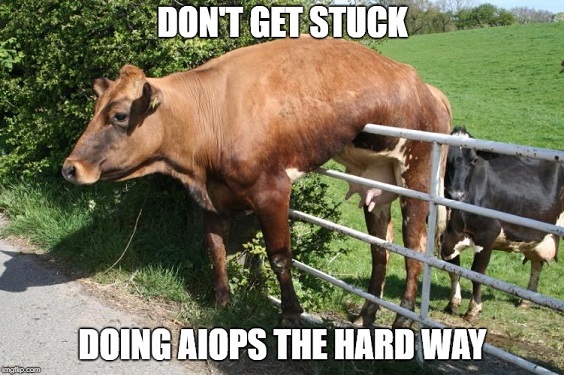AIOps is a technology practice that is drawing lots of attention these days. While AIOps can improve the efficiency of your enterprise IT operations, you should be mindful that there is an easy way to do it and a hard way to do it.
Reducing alert storms
For this article, we will compare methodologies for tackling the most common use case for AIOps: reducing monitoring tool alert noise.
Alert storms/noise is a big problem impacting enterprises everywhere. The sheer quantity of never-ending events bombarding the operations team is overwhelming. As a result, we’ve reached the tipping point where no amount of human power can cope. Enter AIOps.
AIOps done the hard way
One methodology for AIOps that seems perfectly logical is to layer a machine learning platform on top of the monitoring tools. The basic idea is to send all the alerts from all the tools into a big data platform and use machine learning algorithms to give the support teams information that is more precise and actionable.
There are solutions available from Moogsoft, Big Panda, and other emerging vendors that follow this methodology. Alternatively, you can take the DIY road and build your own mousetrap using open source frameworks, ELK, etc.
Regardless if you prefer buying or building, consequently this type of AIOps solution is riddled with problems.
- First, even with the best machine learning, garbage-in always equals garbage-out.
How reliable are the alerts from your monitoring tools? Do you have end users complaining about problems while your monitoring tools show “all green”? If yes, how would adding machine learning fix anything? - Secondly, this methodology does not provide any relief from the massive effort needed for creating, tuning, and managing all the alerting rules in your tools.
- Finally, traditional monitoring tools cannot adapt to the dynamic environments of today. As a result, the alerting schemes are not kept up to date and this creates more garbage-in
The real problem
Instead of applying a band aid on the alert noise, let’s fix the real problem: the garbage-in coming from the monitoring tools.
A perfect analogy for this was said by a DevOps engineer at a major US bank… the leaky house.
Your roof is leaking. The upstairs toilet is leaking. The shower is leaking. There is water coming through the ceiling. What do you do? Do you find a better bucket? No, you fix the leaks.

AIOps done the easy way (the right way)
The only way to deliver on the promise of AIOps is to eliminate the garbage. Dynatrace makes this easy.
Dynatrace automatically monitors your applications, services, transactions, end users, infrastructure, containers and logs with a single solution that deploys in minutes.
By automatically mapping out the millions of dependencies among application components in real time and dynamically adapting as things change on the fly, Dynatrace always knows what is happening – all the way down to the code-level.
Dynatrace provides a deep, accurate, end-to-end understanding of your systems. No more garbage-in.
Because it has reliable, value-rich data coming in, the Dynatrace AI engine will automatically detect problems, automatically pinpoint the underlying root cause, and automatically show the business impact. It gives you answers. No more garbage-out.
This is achieved without creating any alerting rules and without any alert storms.
As a result, Dynatrace solves the alert noise problem automatically. Simple. AIOps done. Voila!
If needed, you can also send data and events from external sources into the AI engine. It’s easy to build on the Dynatrace Smartscape model and take your AIOps strategy to the next level.

See how Dynatrace can eliminate alert storms in 5 minutes or less with a free trial.
Give it a try.





Looking for answers?
Start a new discussion or ask for help in our Q&A forum.
Go to forum